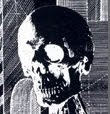 It's Halloween, boys and girls. My favorite holiday, full of horror and charm. My black cat sleeps beside my desk. A jack-o-lantern casts a fiery glow over the room. And I write tonight about automatism and messages from beyond. Yes, I'm talkin' Ouija Boards.
It's Halloween, boys and girls. My favorite holiday, full of horror and charm. My black cat sleeps beside my desk. A jack-o-lantern casts a fiery glow over the room. And I write tonight about automatism and messages from beyond. Yes, I'm talkin' Ouija Boards.Now, now, don't panic. This isn't The Exorcist's deleted scenes blog. Just pop some candy corn and relax.
Talking boards, as they are generically known, get a bad rap from the jittery classes these days. Some people have the notion that these mass-produced printed alphabet boards have the magical power to open doors through which nothing good will ever come, which idea itself is rather mystifying, and I could go on and on about it, but whatever.

There is another, and in my opinion, far more interesting use for these boards -- as a game of surrealist automatism, the practice of drawing creativity straight from the unconscious mind. There are lots of such "automatic" pastimes which stimulate the mind to break logical barriers, to find order in chaos, to make connections between ideas, many of which may have been stolen by art from the occult, or vice versa.
Automatic writing and drawing. Talking boards. Coulage (molten wax, lead, chocolate, etc. dripped into cold water to make shapes) and other liquid arts. Bibliomancy. Even Tristan Tzara's Cut-Up dada poetry technique (keep scrolling down that link till you find it), which works remarkably like a kind of casting of the runes.
 Such things which frighten those who somehow manage to be over- and under-imaginative at the same time, are basic tools of the arts, the gymnasium training machines of creative minds.
Such things which frighten those who somehow manage to be over- and under-imaginative at the same time, are basic tools of the arts, the gymnasium training machines of creative minds.So, to help you overcome your fear of the unknown this All Hallow's Eve, here are a few tricks to treat yourself with:
Play with Brainjar.com's virtual Ouija board, which has already assured me with a definite YES that there are spirits on the web waiting to answer your questions.
Just try not to ask anything dumb, says paranormal researcher, Stephen Wagner, in his About.com article on how to Use A Ouija Board. And in his article answering the question Is It Really Evil? (and who has not asked that about, oh, any number of things?), Mr. Wagner will explain all that to you, too.
Finally, if trademarked commercial toys are not your preferred avenue to the beyond within, knock your brains out with the random generators of WatchOut4Snakes, to which I just got addicted but good. Behold!
The random word generator wrote a poem:
She burked the raucous slaughterhouse
amid a disrupted paradigm.
The wonderful music beats the feat over the obliging evidence, [and that]
A turned success dogs the witty midnight.
The deprived affair catalogs surrealism next to the inconvenient muddle. Above, Ouija boards puzzle the token. Ouija boards wash an indirect novel over a differing search. Why can't the worship breathe outside a mass riot? Ouija boards degrade the unbelievable office.Oh, I'm going to have fun with that site.
So, don't be afraid. Tonight is the night when shadows walk (actually, they always do that, don't they?), when dreams look back at you from the mirror (if you say their names three times), and when you know perfectly well you are going to watch movies full of gore and terror, and dress up as the dead, and feed candy eyeballs to your children. You may as well break out the old Ouija, too.
You might even conjure the ghost of Sigmund Freud.

Boo!
-- Jen
(note: images of talking boards and toys are from the Museum of Talking Boards, linked; Ouija is a proprietary trademark, but a Google search left me unsure whose.)








